John Groves
Operetta Research Center
1 February, 2017
Eduard Künneke (1885-1953) has been described by Kurt Ganzl as “the most appreciable German composer for the mid-20th-century musical stage”; he composed more than 30 operas, operettas and singspiele, yet only one, Der Vetter aus Dingsda (1921), usually translated into English as The Cousin from Nowhere, is frequently performed. Dessau has a magnificent 1,200 seat theatre set in parkland and has just staged a rare revival of Künneke’s Lady Hamilton (1926), probably the only operetta ever to be set in the Kent port of Ramsgate!

David Ameln (as Percy Harwich), Christel Ortmann (as Mary Ann), Rodrigo Porras Garulo (as Don Alfredo Bartos) in “Lady Hamilton.” (Photo: Claudia Heysel)
In fact the Pelican Inn, where the first act is set, still exists a few kilometers south of the town. The plot concerns the rise of Emma Lyons, charmingly sung and acted by Cornelia Marschall, from barmaid to wife of fifty-one years old Sir William Hamilton and eventually mistress of Lord Nelson, via various dalliances with, amongst others, Don Alfredo Bartos portrayed with fervor and dash by Rodrigo Porras Montero, who has the best know number in the show, and one of the very few waltzes: “Du Hast Augen, von denen man träumt.” In fact, it is a shame that he does not have more to do as this one song is virtually all he sings!
Comic, rather than romantic, interest is maintained by David Amelin in the role of Lord Percy Harwich (Harwich being a port on the Essex coast of England), who shares the wonderful duet “Komm mit nach Madrid” with Emma; whilst she is flirting with him in Act Two.
He is suitably dashing and athletic, and exudes energy whenever he is onstage.
Mention of this duet brings me to the music itself. It is simply wonderful: uplifting and very catchy throughout. The melodies simply burst with life and energy – especially the duet just mentioned. In addition Künneke’s piquant harmonies with often unusual if not daring chords add a rare spice to the whole score. The composer had worked in America for two years prior to composing Lady H, and was clearly influenced by Tin Pan Alley composers such as Sigmund Romberg: for example the Act One position of Emma’s foxtrot “Jeden Abend tönt der Gong” is similar to that of the Drinking Song in The Student Prince.
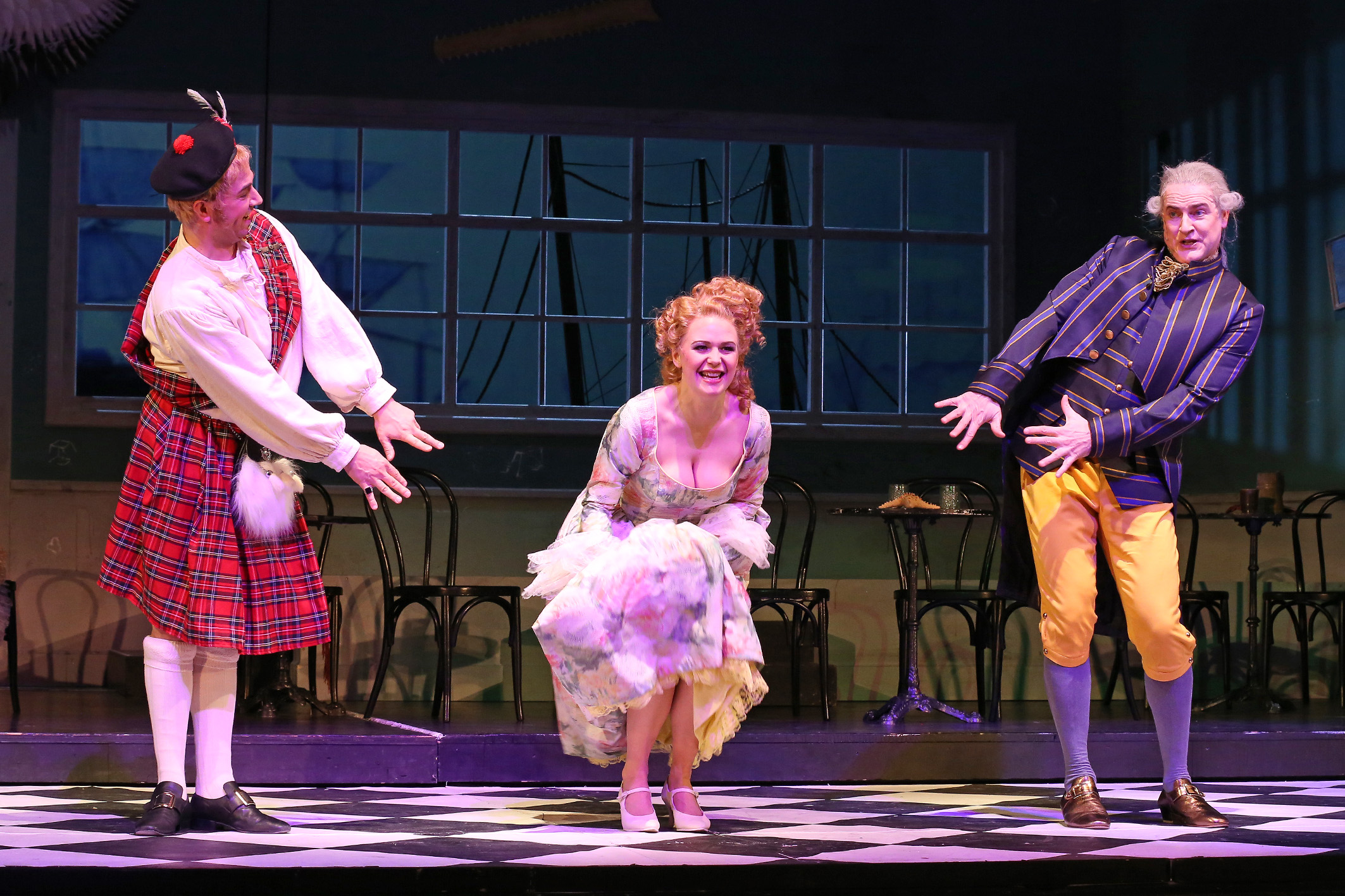
David Ameln (as Percy Harwich), Annika Boos (as Kitty Grant), Alexander Nikolić (as George Romney) in “Lady Hamilton.” (Photo: Claudia Heysel)
Other major roles include Kitty Grant, played with great comic timing and verve by Annika Boos, who is the artist George Romney’s ‘model’. (Emma also flirts with him!). He, again, is sung and acted with great aplomb by Alexander Nikolic. Sir William, (or occasionally in the libretto ‘Lord’ – Richard Bars and Leopold Jacobson do not seem to have realized that there is a difference!) acted by Karl Thiele, never sings, which means that he comes across as rather two-dimensional: not the actor’s fault – he makes him suitably stiff-upper-lip British!
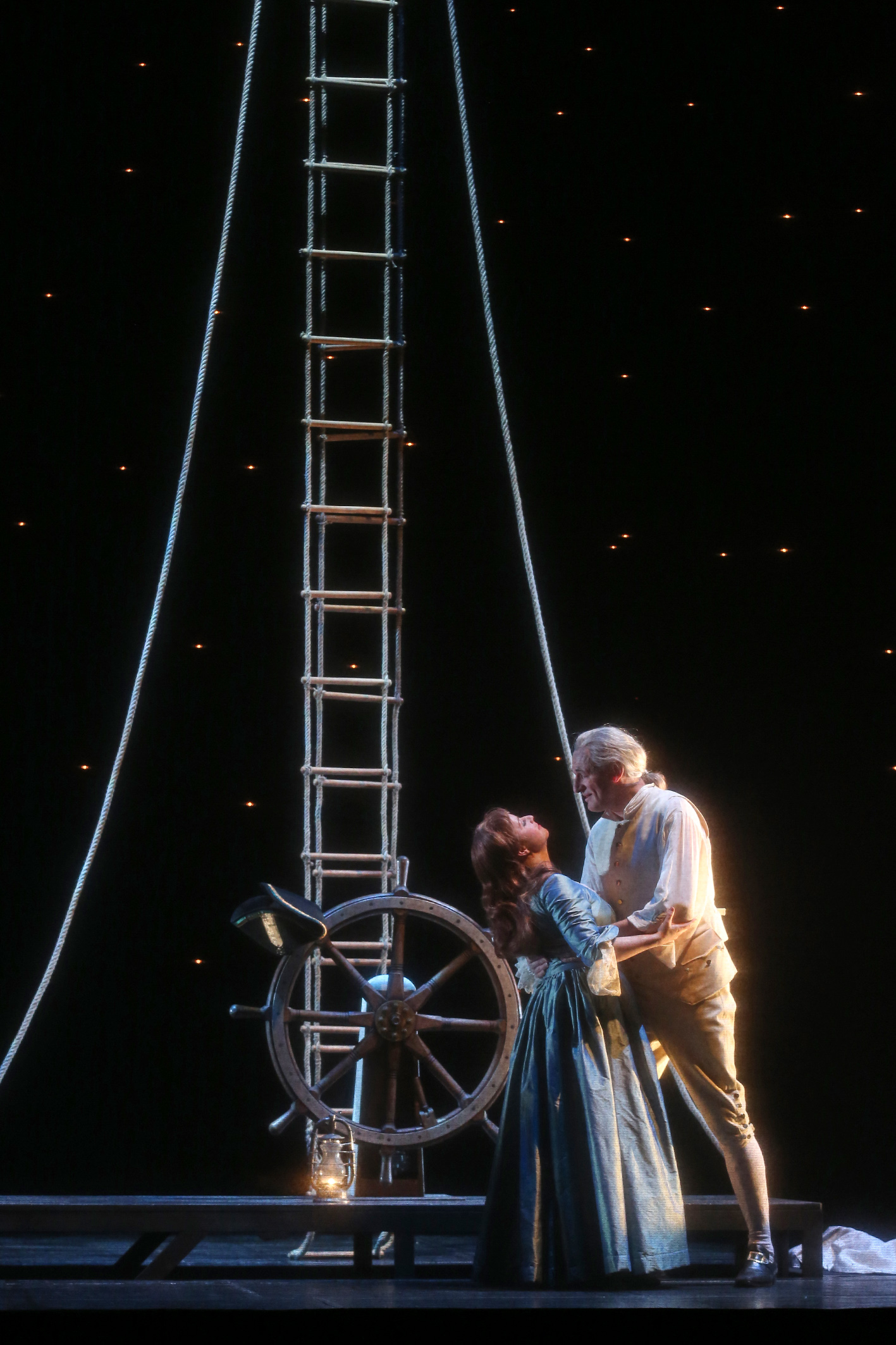
Cornelia Marschall (as Amy Lyon), Stephan Korves (as Horatio Nelson) in “Lady Hamilton.” (Photo: Claudia Heysel)
Captain Horatio Nelson (Stephan Korves), whom we only see in Act Three when he first ‘meets’ Emma and then at the very end when the lights finally dim and whatever they are about to do is left to the imagination! is also a speaking role, a shame as the very end of the operetta cries out for a romantic duet (as in Oscar Straus’ Perlen) when all we get are a few bars played by the orchestra! Nelson is portrayed in this production as someone who is ‘mature’ with white hair, yet in fact he was only 23 years old in 1781 when the operetta is set, so should be a dashing young naval officer whom Emma would fall for.
Musically, the whole production is superb! Rarely have I heard a chorus of a regional German opera house sing with such fullness of tone.
The orchestra under the baton of Elisa Gogou plays with the necessary style and grace and never overwhelms the singers. The score calls for three saxophones which are used as part of the whole soundscape, rather than just the ‘jazzy’ moments. Künneke uses a similar orchestra for his Dance Suite Op 26, which he recorded with the Berlin Philharmonic in 1938.
Set design (Moritz Nitsche) is on a grand scale! The colorful set for the Pelican Inn in Act One moves slowly apart to reveal the Bay Of Naples for Act Two, which slowly moves downstage, a beautifully painted backdrop behind Grecian columns: it is worth visiting the production for this set-change alone!! In the first scene of the third act (after the interval) we meet Nelson for the first time and also witness his first meeting with Emma: the set here is suitably simple yet so evocative, as well as being beautifully lit. The eruption of Vesuvius at the very end of Act Three is a must-see moment!
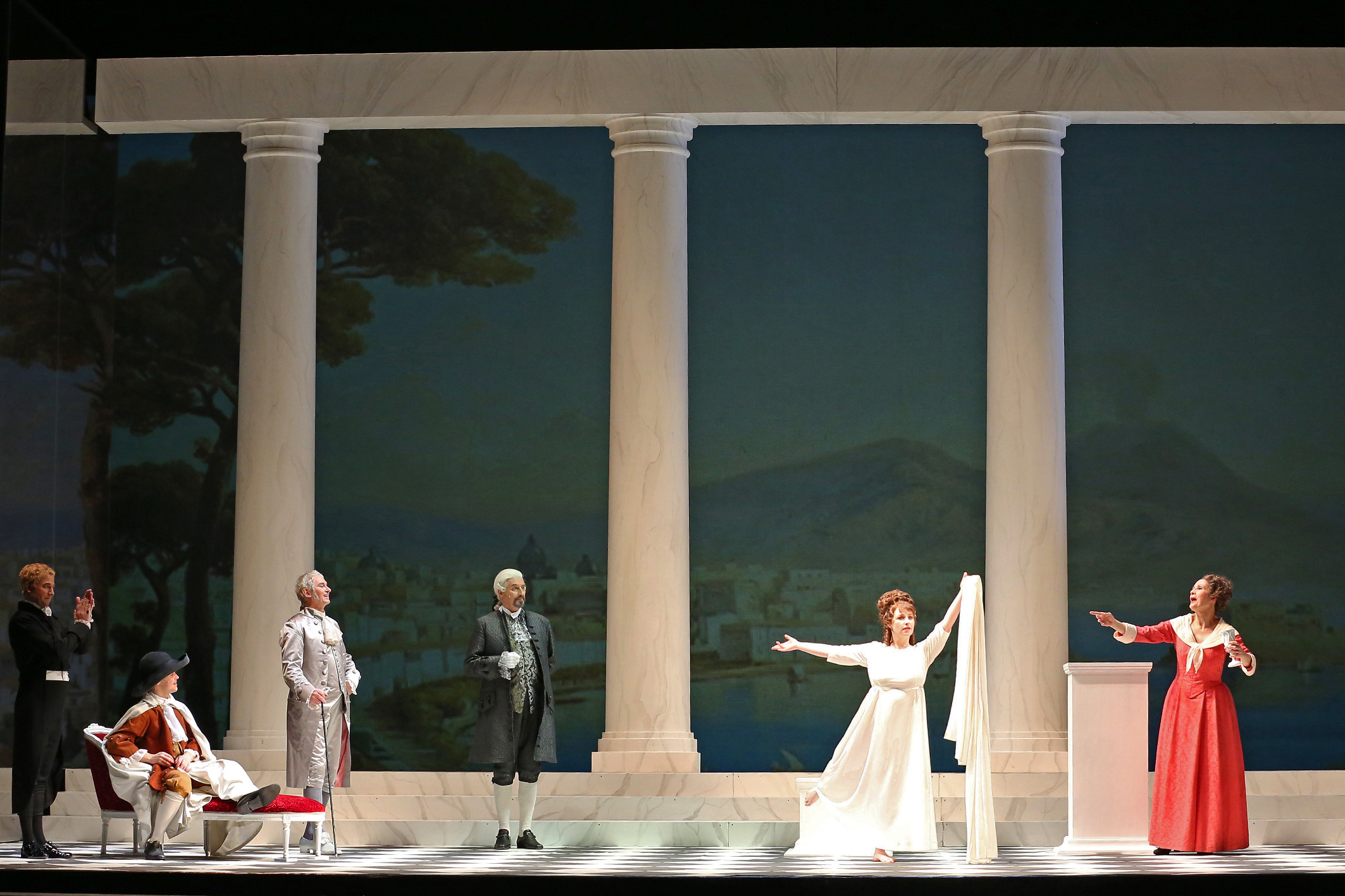
David Ameln (as Percy Harwich), Tizian Steffen, Karl Thiele (as Sir William Hamilton), Boris Malré (as Jonny), Cornelia Marschall (as Amy Lyon), Christel Ortmann (as Mary Ann) in “Lady Hamilton.” (Photo: Claudia Heysel)
Costume design (Judith Fischer) is, if anything, even more lavish! The chorus is costumed individually, showing great imagination: a cardinal, Scotsman complete with bagpipes etc, and all the ladies’ gowns are simply sumptuous. Uniform has been designed and made with great attention to detail and look accurate and totally convincing.
The director, Johannes Weigand, has not allowed himself to be influenced by what is going on at Komische Oper Berlin, even though that is only 130 km away!
His production is totally traditional, treating the operetta with a great deal of respect, and showing us something of the original 1926 Breslau production. This works well in the first two acts, which are witty and have pace: he has chosen his cast well, all being very competent actors who use the dialogue with intelligence and are able to pace it so that it always leads fluidly into musical numbers. Occasionally, such as in the opening scene, the stage, which is very wide, looks cramped, as he does not allow the chorus to use the forestage and when they exit they all have to do so through one door!, but on the whole he marshals his forces well and often imaginatively, with a good idea for the picture he wishes to create.
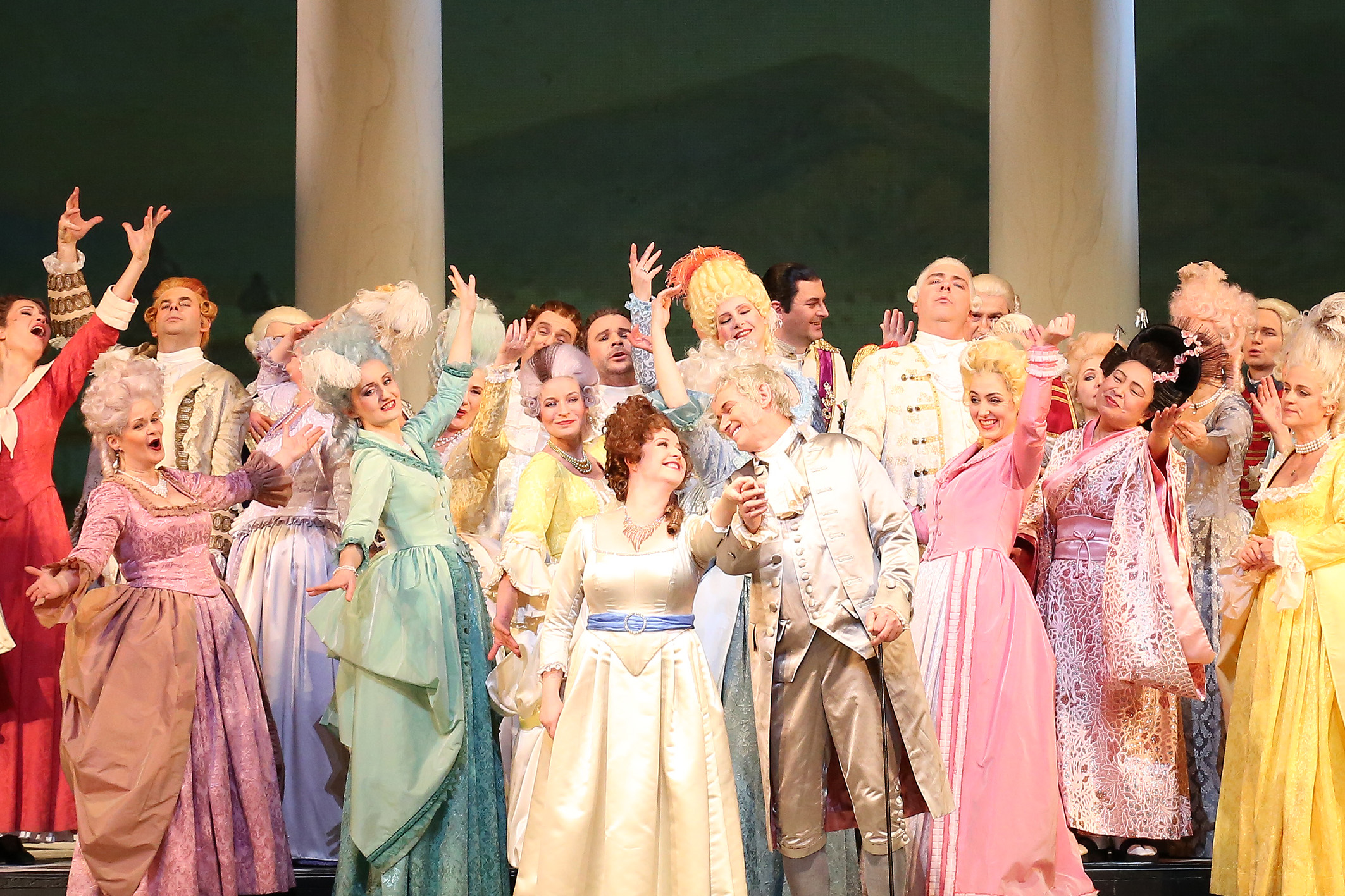
Cornelia Marschall (as Amy Lyon), Karl Thiele (as Sir William Hamilton) and chorus in “Lady Hamilton.” (Photo: Claudia Heysel)
The problem is the structure of Act Three which, as in many three-act operettas, is the weakest, whereas it should be the strongest, leading up, as it does, to whatever Lady H and Nelson get up to after the curtain falls!. It lasts 50 minutes and is nearly all dialogue, occasionally underscored. There is only one musical break – Kitty and Percy’s duet ‘Täglich im Leid’ which is delightful. Nearly all the cast, including the chorus, can go home during the interval as the act mostly involves Hamilton and Nelson, both of which are non-singing roles!
But that is the only slight downside to what is, certainly in the first two acts, a totally delightful show: one which is more than worth reviving after so long! It is certainly well worth while making the journey to Dessau to see Lady Hamilton and what she gets up to! And as for the gorgeous music – that is worth hearing over and over again!
There is a recording available made in 1953 and orchestrated and conducted by Künneke’s friend, Franz Marszalek, who also conducted the 1926 premiere. This features Anny Schlemm, Franz Fehringer and Willy Hoffmann and is so lively and vibrant that the singers’ enthusiasm easily overcomes the slightly dated recording.
I have not dealt with the complex production history of the show: Sabine Müller will be publishing her biography of Künneke later in 2017, unfortunately only in German!
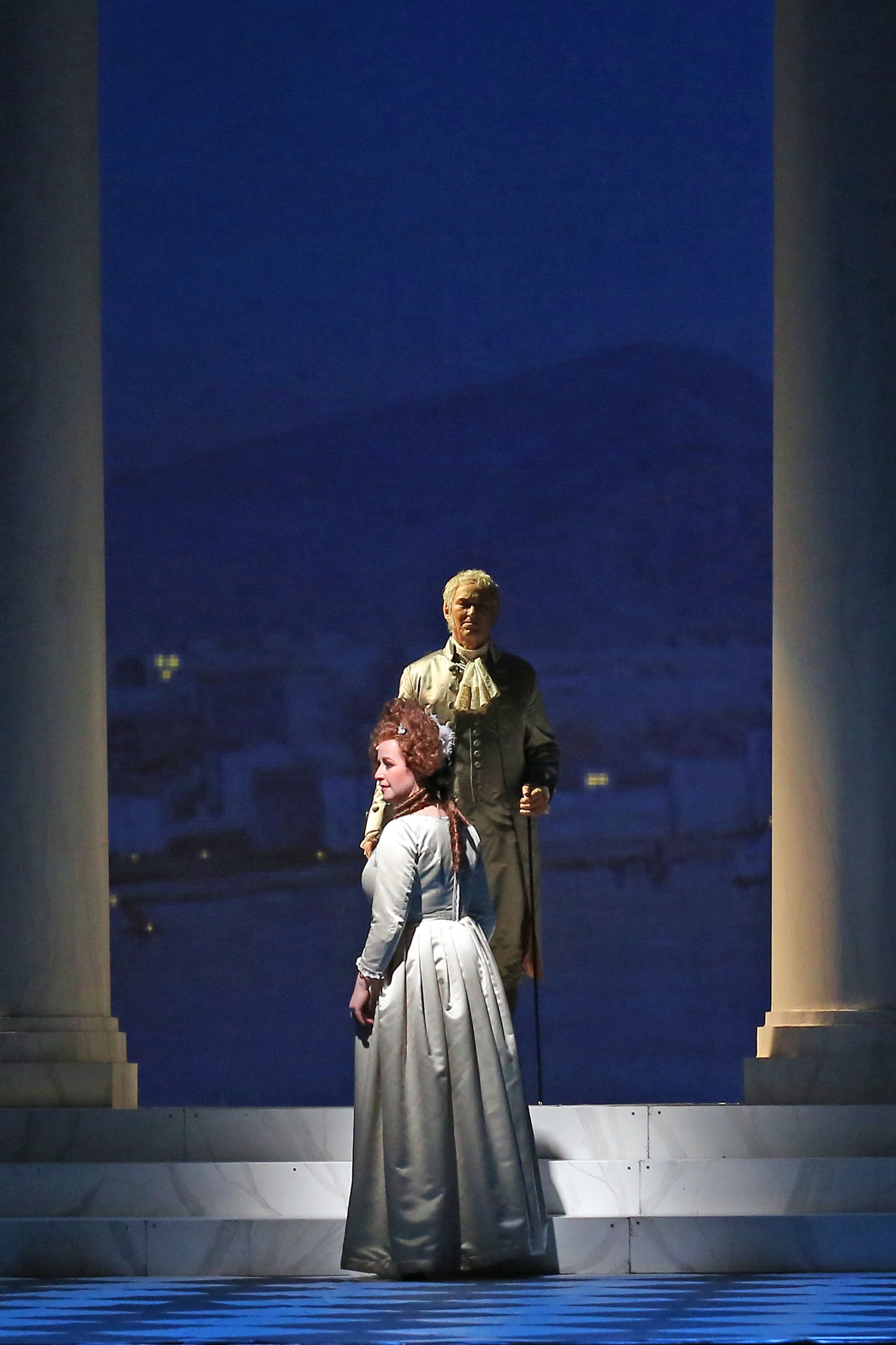
Cornelia Marschall (as Amy Lyon), Karl Thiele (as Sir William Hamilton) in “Lady Hamilton.” (Photo: Claudia Heysel)
Lastly, one would think that an operetta about Nelson, set in Ramsgate, would have appealed to a British audience: the operetta was produced in London in 1928, but the names of all the principal characters were changed as it was thought that the historically inaccurate story might offend!! It starred Stanley Holloway and silly-ass Claude Hulbert, being conducted by Percy French and ran for over 150 performances.
Anhaltisches Theater, Dessau, must be congratulated on mounting this production, especially in straightened economic times. The result is more than worthwhile and one hopes that the ‘full house’ for the premiere is replicated throughout the season. I would cheerfully see it again – especially for that wonderful music!
For performance dates, click here.

I have been campaigning for Eduard K for years & plan to publish my own biography of Künneke (in English) at some point soon. I have given several highly appreciated talks on him in the UK and produced a CD The Prof & the Showgirl in 2011 for Magdalen which I was ran at the time. I also hope to issue another CD of his music on my Amare Classics label at some point. It will include music from Lady Hamilton. I am just hoping that I can get to see this production and also catch Theater Hof’s Vetter aus Dingsda before it closes.
I have the Prof and the Showgirl CD – thanks, James! Do let me know when your Kunneke biography is published.
My wife and I saw the performance on 8 April which also included a fascinating discussion afterwards at the Altes Theater between Sabine Müller and the director with musical interludes provided by Annika Boos & David Amelin and pre-recorded Künneke extracts. Your comments about this production were spot on. It was huge fun, although the theatre was sadly not full (maybe the starting time of 5pm was difficult for some). Thankfully though, Mr K’s star is on the rise again and I’m now saving up for Die grosse Sünderin in Leipzig. You guys at Operetta Research Center have the best job!